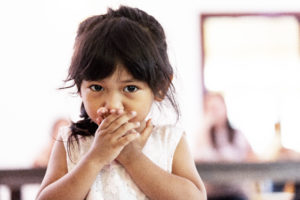 Social anxiety causes feelings of panic or fear during interactions with people. It can occur only in certain situations or nearly all of the time. For adults, it often means avoiding other people, groups, or large crowds. But social anxiety can show up much earlier in life. In infants and toddlers, social anxiety will look much different that it does in adults.
Social anxiety causes feelings of panic or fear during interactions with people. It can occur only in certain situations or nearly all of the time. For adults, it often means avoiding other people, groups, or large crowds. But social anxiety can show up much earlier in life. In infants and toddlers, social anxiety will look much different that it does in adults.
Where Does Social Anxiety Come From?
It can be hard to pinpoint what causes social anxiety in infants and young children. One study found infants could learn socially anxious behavior from their mothers. A mother with social anxiety may display those behaviors to a child through interactions with strangers. The study indicated these nonverbal cues could teach the child that strangers are a source of anxiety.
Genetics also affect whether a child will have social anxiety. Genes help determine an infant’s disposition, or personality. Research shows certain genetic traits can increase risk for anxiety and situational phobias. Some of these traits may include inhibition and fear of being judged. Fear in low-threat situations could also help predict social anxiety.
Home life and environment can exacerbate risk factors. Trauma could trigger social anxiety at a young age. Addressing these issues with children early may pave the way for good mental health in the future. In addition, the severity of a child’s social anxiety can vary. Some children grow out of it as they develop, while others internalize the anxiety when they are older.
Signs of Social Anxiety in Infants and Toddlers
Social anxiety may look similar to shyness, separation anxiety, or autism. There is no set age when symptoms start to appear. It is common to notice social anxiety in preschool or other social settings. However, parents may notice signs that could predict social anxiety in children from the time they are newborns.
Signs of social anxiety in infants may include:
- Fear of or disinterest in new things
- Difficulty calming down
- Strong reactions to small changes
- Being upset by new noises or people
- Seeming overly sensitive to mild discomfort
These behaviors can be stressful for parents. Infants cannot communicate clearly what is causing them distress. Parents may worry their child is in pain or that they have done something wrong.
As infants grow into toddlers, their social anxiety may appear in other ways. It may be easier to understand what is causing a toddler stress. But knowing how to deal with a socially anxious toddler can still be challenging.
Signs of social anxiety in toddlers may include:
- Fears and phobias
- Refusal to give up routines
- Noise or tactile sensitivity
- Dislike for getting dirty
- Lengthy rituals
- Picky eating
- Following parents constantly
- Shyness or distrust of strangers
- Sleep problems
Parents of a socially anxious toddler may worry they are raising a “difficult” child. This causes some parents to punish their child for anxious behavior. Punishing a child for signs of social anxiety can have the opposite effect of what is intended. Toddlers who are punished for anxiety-rooted behavior may “close off” from parents. One study showed that harsh parenting may cause an already fearful toddler to become even more anxious. It also led to lowered neural processing ability in preschool.
A therapist can help address behavior issues that stem from social anxiety. They can show parents how to work with the behavior constructively.
How Are Separation Anxiety and Social Anxiety Related?
Reading books or watching movies that depict confident young children can give watching toddlers a hero to mimic.
Separation anxiety can be normal in young children. They may cry or become worried when a parent drops them off or leaves the room. But separation anxiety may be soothed in the short term. Some parents use entertaining distractions to help kids settle into social situations.
But for toddlers with social anxiety, distractions may not improve the situation. Social anxiety can cause children to worry about being around others as well as separation from parents.
Social anxiety can stem from separation anxiety, or both may occur together. Toddlers with social anxiety may seem afraid to participate in group activities or play with peers. If they also have separation anxiety, it may be difficult to calm them after a parent leaves. This can make preschool or daycare a stressful event.
Tips for Parents of Socially Anxious Infants and Toddlers
If an infant shows signs of social anxiety, it can help to model calm, self-soothing behavior. Modeling healthy reactions in social settings can help teach young children these behaviors. In addition, giving toddlers a chance to practice before new situations may help them feel more confident. For example, a parent might invite them to practice show-and-tell before the big day. Reading books or watching movies that depict confident young children can give watching toddlers a hero to mimic.
Instead of feeding into fearful behaviors, it can be more helpful when parents give enthusiastic praise when toddlers try something new. Explaining a child’s anxiety to any caregivers, teachers, and other parents will help them understand their behavior. This can help inform how they act around the child. Caregivers can help by fostering positive interactions. This can reinforce the idea that others do not have to be a source of anxiety.
Medication and Socially Anxious Infants and Toddlers
It is considered best practice to not give medication to children under the age of 5, except in extreme cases. Social anxiety does not typically warrant medication at this age. Young children are sensitive to the effects of medication. Medicating too early may cause unwanted side effects. If the anxiety persists when the child is older, consult a professional about the next step for treatment.
How Therapy Can Help Infants and Toddlers with Social Anxiety
It may be too soon to tell if an infant or toddler has social anxiety. A therapist can help parents or caregivers address behaviors that indicate a child’s discomfort in social settings. Some therapists specialize in mental health issues in young children. They may give an assessment that more clearly reveals where the child is struggling.
Seeing a family therapist together can be helpful for parents. It can give them guidance for any difficulties they have in helping their child. Seeing parents talk calmly with a therapist can help children with social anxiety understand the social setting is safe for them. A therapist may also be able to identify root causes of a child’s social anxiety.
Children grow and change over time. Understanding that it is always okay to ask for help is a lesson they are likely to take with them through the rest of their life.
References:
- A guide for community child serving agencies on psychotropic medications for children and adolescents. (2012). American Academy of Child & Adolescent Psychiatry. Retrived from https://www.aacap.org/App_Themes/AACAP/docs/press/guide_for_community_child_serving_agencies_on_psychotropic_medications_for_children_and_adolescents_2012.pdf
- Brooker, R. J., & Buss, K. A. (2014). Harsh parenting and fearfulness in toddlerhood interact to predict amplitudes of preschool error-related negativity. Developmental Cognitive Neuroscience, 9, 148-159. doi: 10.1016/j.dcn.2014.03.001
- Buss, K. A. (2011). Which fearful toddlers should we worry about? Context, fear regulation, and anxiety risk. Developmental Pscyhololgy, 3(47), 804-819. Doi: https://doi.org/10.1037/a0023227
- Cuncic, A. (2018, February 16). How to cope as a parent of a preschooler with social anxiety. Retrieved from https://www.verywellmind.com/preschool-child-with-social-anxiety-3024286
- de Rosnay, M., Cooper, P. J., Tsigaras, N., & Murray, L., (2006). Transmission of social anxiety from mother to infant: An experimental study using a social referencing paradigm. Behaviour Research and Therapy, 8(44), 1165-1175. Doi: https://doi.org/10.1016/j.brat.2005.09.003
- Kendler, K. S., Prescott, C. A., & Meyers, J. (2003, January 9). The structure of genetic and environmental risk factors for common psychiatric and substance use disorders in men and women. Arch Gen Psychiatry, 9(60), 929-931. doi: 10.1001/archpsyc.60.9.929
- Rogers, C. E., Sylvester, C. M., Mintz, C., Kenley, J. K., Shimony, J. S., Barch, D. M., & Smyser, C. D. (2017). Journal of the American Academy of Child & Adolescent Psychiatry, 2(56), 157-166. doi: https://doi.org/10.1016/j.jaac.2016.11.005
- Schwartz, C. E., Wright, C. I., Shin, L. M., Kagan, J., & Rauch, S. L. (2003, June 20). Inhibited and uninhibited infants “grown up”: Adult amygdalar response to novelty. Science, 5627(300), 1952-1953. doi: https://doi.org/10.1126/science.1083703
- Social anxiety: Risk factors. (n.d.). Retrieved from https://childmind.org/guide/social-anxiety-disorder/social-anxiety-disorder-risk-factors
- Versfeld, P. (n.d.). The highly sensitive child and behavioral inhibition. Retrieved from https://skillsforaction.com/highly-sensitive-child

The preceding article was solely written by the author named above. Any views and opinions expressed are not necessarily shared by GoodTherapy.org. Questions or concerns about the preceding article can be directed to the author or posted as a comment below.

 What Social Anxiety Feels Like and Where It Comes From
What Social Anxiety Feels Like and Where It Comes From Not Just for Introverts and Loners: 5 Myths About Social Anxiety
Not Just for Introverts and Loners: 5 Myths About Social Anxiety Stressful School Year? Use Summer to Help Your Student Manage Anxiety
Stressful School Year? Use Summer to Help Your Student Manage Anxiety

Please fill out all required fields to submit your message.
Invalid Email Address.
Please confirm that you are human.
Leave a Comment
By commenting you acknowledge acceptance of GoodTherapy.org's Terms and Conditions of Use.